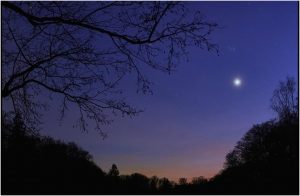Venus Morning and Evening Star

Enigmatic Venus is our closest planetary neighbour and is the brightest planet in the sky. She looks like a star with the naked eye but unlike stars that emit their own light, Venus is a planet and reflects the light from the Sun.
Venus is the second planet closest to the Sun, Earth being the third, and never ventures very far from the Sun from our perspective on Earth. Sometimes when she is very close to the Sun, she is lost in its glare and becomes invisible. When she is at her furthest separation from the Sun –referred to as “greatest elongation” – Venus is so bright that she becomes the third brightest object in the sky after the Sun and Moon.
As Venus travels around the Sun inside the Earth’s orbit, she alternates from evening to morning sky, spending about 9.5 months in each. She can be seen either just after sunset in the west as the bright Evening Star or just before sunrise in the east as the Morning Star. The ancient Greeks and Egyptians thought that Venus was actually two separate objects. The Greeks called the Morning Star Phosphoros or Lucifer, “the bringer of light”; or “shining one”; and they called the Evening Star Hesperos, “the star of the evening” or “western star”.
As she transitions between Evening and Morning Star and becomes temporarily invisible, her energy also shifts. As a Morning Star, Venus is led by the emotions with a fresh, spontaneous, eager, resilient emotional nature. As Evening Star she has a more deliberate and goal-oriented emotional make-up, is more controlled, introverted and slower to process and connect with feelings.
Venus is a Morning Star if it is behind the Sun by zodiac degree and an Evening Star if it is ahead of the Sun by zodiac degree in your chart. For example if your Sun is at 28 degrees of Virgo and your Venus is at 10 degrees of Scorpio you are a Morning Star; if Venus is at 10 degrees of Scorpio and your Sun is at 18 degrees of Sagittarius you are an Evening Star.
In astrology Venus symbolises the principle of attraction – who and what we are attracted to and who and what we attract to us – such as people, things, resources, money as well as our values. As Goddess of love she is associated with intimate and social relationships, romance, partnerships as well as beauty, aesthetics and pleasure. Venus is never found more than 48 degrees from the Sun in the natal astrology chart.
Around 27 May 2020 Venus will all but disappear from the evening sky. On 3 June she will conjunct the Sun i.e. seem to pass between the Earth and the Sun as she transitions from an evening to morning star. During this time we are symbolically in the dark and relationship themes are magnified. This marks the beginning of a new Venus cycle and is significant as it forms part of the Venus retrograde cycle which you can read about in Part 2 . She becomes visible again from mid June onwards, refreshed and re energised in the morning sky for the rest of 2020, being at her brightest again on 10 July.

